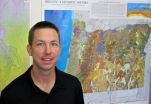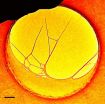(Press-News.org) Children with hearing loss struggle to hear in noisy school classrooms, even with the help of hearing aids and other devices to amplify their teacher's voice. Training the brain to filter out background noise and thus understand spoken words could help the academic performance and quality of life for children who struggle to hear, but there's been little evidence that such noise training works in youngsters.
A new report showed about a 50 percent increase in speech comprehension in background noise when children with hearing impairments followed a three-week auditory training regimen. The effect was still evident when the children were tested three months after the training ended.
The findings are among the first to demonstrate that auditory training with noise can work in children. Other studies show that similar regimens help hearing-impaired adults.
The training involves repeated exposure to speech masked by noise, and is intended to teach the brain how to receive information and process it more efficiently. This could help hearing-impaired children who struggle to keep up in noisy classrooms.
"It's not a fair playing field with their normal-hearing peers," said Jessica Sullivan, lead author and a University of Washington assistant professor of speech and hearing sciences. "They have the best technology, but it's not enough – they still miss things."
People with normal hearing usually filter out background noise seamlessly. If a loud truck rumbles by, they can still understand a conversation because their brains work quickly to fill in sounds that they might have missed.
But people with hearing loss take in sound more slowly, and brain regions that process hearing aren't as adept at filling in muffled information.
In Sullivan's study, published in the January issue of the Journal of the Acoustical Society of America, hearing-impaired youngsters ages 6 to 17 attended seven one-hour sessions spread across three weeks. They listened to a series of sentences, such as "We saw two brown bears" or "Grandmother gave Bob red beans," masked by staticky background noise intended to simulate a clattering classroom scene.
During the sessions, Sullivan gradually made the regimen more demanding by ratcheting up the number of words in the sentences, the noise volume and the time between hearing the sentence and identifying what words were said. The children had to give correct answers 80 percent of the time before advancing to the next level of difficulty.
Three months after the training, the participants still showed improvements in word recognition over the noise.
Sullivan also found that auditory training with a crackling noise – called "interrupted" because white noise was interspersed with fleeting five- to 95-millisecond silences – increased hearing comprehension more than using continuous white noise. Children in the interrupted noise group showed about a 50 percent increase in speech intelligibility compared with their hearing at the beginning of the experiment.
"The maintenance of the improvement is a truly significant finding," Sullivan said. "It indicates that new hearing and listening strategies have been developed to detect speech despite noise."
The next step in the research is to see how the regimen works for other people, such as adults and cochlear-implant users, and to other types of noise, including real-world settings.
###
Co-authors are Linda Thibodeau and Peter Assmann of the University of Texas at Dallas, where the study was conducted. The study was funded by the National Institute on Deafness and Other Communication Disorders.
For more information, contact Sullivan at 206-616-5273 or sulli10@uw.edu.
Research paper: http://asadl.org/jasa/resource/1/jasman/v133/i1/p495_s1. END
Noisy classroom simulation aids comprehension in hearing-impaired children
2013-02-11
ELSE PRESS RELEASES FROM THIS DATE:
Large, ancient landslides delivered preferred upstream habitats for coho salmon
2013-02-11
EUGENE, Ore. (Feb. 11, 2013) -- A study of the Umpqua River basin in the Oregon Coast Range helps explain natural processes behind the width of valleys and provides potentially useful details for river restoration efforts designed to improve habitats for coho salmon (Oncorhynchus kisutch).
Coho salmon thrive in broad, flat valleys that contain multiple auxiliary channels to the main river. These valleys formed after large landslides altered the landscape, said study co-author Joshua J. Roering, professor of geological sciences at the University of Oregon. The network ...
Visualizing biological networks in 4-D
2013-02-11
PASADENA, Calif.—Every great structure, from the Empire State Building to the Golden Gate Bridge, depends on specific mechanical properties to remain strong and reliable. Rigidity—a material's stiffness—is of particular importance for maintaining the robust functionality of everything from colossal edifices to the tiniest of nanoscale structures. In biological nanostructures, like DNA networks, it has been difficult to measure this stiffness, which is essential to their properties and functions. But scientists at the California Institute of Technology (Caltech) have recently ...
Old drug may point the way to new treatments for diabetes and obesity
2013-02-11
ANN ARBOR — Researchers at the University of Michigan's Life Sciences Institute have found that amlexanox, an off-patent drug currently prescribed for the treatment of asthma and other uses, also reverses obesity, diabetes and fatty liver in mice.
The findings from the lab of Alan Saltiel, the Mary Sue Coleman director of the Life Sciences Institute, are scheduled to be published online Feb. 10 in the journal Nature Medicine.
"One of the reasons that diets are so ineffective in producing weight loss for some people is that their bodies adjust to the reduced calories ...
New genes for short-sightedness identified
2013-02-11
An international team of scientists led by King's College London has discovered 24 new genes that cause refractive errors and myopia (short-sightedness).
Myopia is a major cause of blindness and visual impairment worldwide, and currently there is no cure. These findings, published today in the journal Nature Genetics, reveal genetic causes of the trait, which could lead to finding better treatments or ways of preventing the condition in the future.
Thirty per cent of Western populations and up to 80 per cent of Asian people suffer from myopia. During visual development ...
NIH scientists discover promising target to block Staphylococcus infection
2013-02-11
National Institutes of Health (NIH) scientists have identified a promising lead for developing a new type of drug to treat infection caused by Staphylococcus aureus, a bacterium that frequently resists traditional antibiotics. The researchers discovered a system used by S. aureus to transport toxins that are thought to contribute to severe staph infections. These toxins—called phenol-soluble modulins (PSMs)—have gained much attention in recent years, but their multitude and diversity have hindered efforts to target them for drug development.
Expanding on work that first ...
Birds evolved ultraviolet vision several times
2013-02-11
Ultraviolet vision evolved at least eight times in birds from a common violet sensitive ancestor finds a study published in BioMed Central's open access journal BMC Evolutionary Biology. All of these are due to single nucleotide changes in the DNA.
Modern daytime birds either have violet sensitive or ultraviolet sensitive vision. Being ultraviolet sensitive alters visual cues used to select a mate, avoiding predators, and in finding food. Researchers from Uppsala University and the Swedish University of Agricultural Sciences sequenced the genes responsible for producing ...
U of M researchers develop a molecular 'calcium sponge' to tackle heart failure
2013-02-11
MINNEAPOLIS/ST. PAUL (February 10, 2013) – Researchers at the University of Minnesota's Department of Integrative Biology and Physiology and the Lillehei Heart Institute have utilized molecular genetic engineering to optimize heart performance in models of diastolic heart failure by creating an optimized protein that can aid in high-speed relaxation similar to fast twitching muscles.
Within heart cells, calcium plays a major role in orchestrating normal heart pump function. However, in diastolic failure the calcium signaling process is slowed; calcium levels rise to ...
Exercise linked with reduced prostate cancer risk in Caucasians but not African Americans
2013-02-11
A new study suggests that exercise may reduce Caucasian men's risk of developing prostate cancer. And among Caucasian men who do have prostate cancer, exercise may reduce their risk of having more serious forms of the disease. Unfortunately, the benefits do not seem to apply to African- American men. The study is published early online in CANCER, a peer-reviewed journal of the American Cancer Society.
Previous research has linked exercise to a reduced risk of developing prostate cancer. Studies have also revealed that African-American men have an increased risk of developing ...
Review: Few effective, evidence-based interventions for children exposed to traumatic events
2013-02-11
RESEARCH TRIANGLE PARK, N.C. – About two of every three children will experience at least one traumatic event before they turn 18. Despite this high rate of exposure, little is known about the effectiveness of treatments aimed at preventing and relieving traumatic stress symptoms that children may experience after such events, according to researchers at RTI International, the University of North Carolina School of Medicine, the RTI-UNC Evidence-based Practice Center, and Boston Medical Center.
The article, published today in the journal Pediatrics, summarizes the results ...
Grand Millennium Dubai Prepares for ITB Berlin
2013-02-11
Participating in the ITB Berlin under the Dubai Department of Tourism & Commerce Marketing umbrella, a team from the Grand Millennium Dubai will be presenting a set of competitive leisure packages to the leading tour operators from Germany and elsewhere in Europe.
Leading the team will be Director of Sales Ghassan Farhat.He said it will be the fifth time for the hotel to be in Berlin at the world's largest travel show, and he was confident of securing new business there, as well as reinforcing existing contacts and contracts.
"Figures show that the average ...


